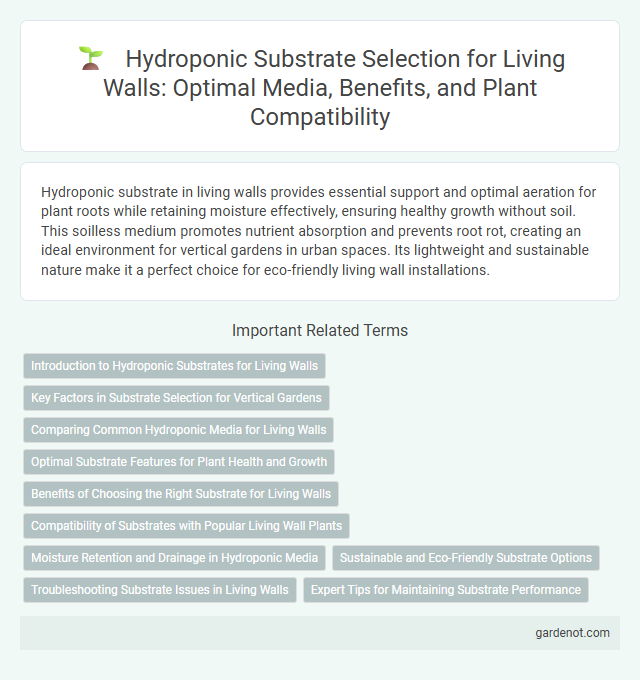Hydroponic substrate in living walls provides essential support and optimal aeration for plant roots while retaining moisture effectively, ensuring healthy growth without soil. This soilless medium promotes nutrient absorption and prevents root rot, creating an ideal environment for vertical gardens in urban spaces. Its lightweight and sustainable nature make it a perfect choice for eco-friendly living wall installations.
Introduction to Hydroponic Substrates for Living Walls
Hydroponic substrates for living walls are specially designed materials that support plant roots while facilitating optimal water and nutrient delivery in soilless systems. Common substrates include rock wool, coconut coir, perlite, and clay pellets, each offering unique properties such as excellent aeration, moisture retention, and structural stability. These substrates enhance root oxygenation and nutrient absorption, promoting healthier and faster plant growth in vertical garden installations.
Key Factors in Substrate Selection for Vertical Gardens
Hydroponic substrate selection for living walls hinges on factors such as water retention capacity, aeration, and nutrient-holding ability, which directly influence plant health and growth efficiency. Substrates like coconut coir, perlite, and rock wool are favored for their balance of moisture retention and oxygen availability crucial for vertical garden systems. Ensuring optimal substrate pH and minimal compaction supports root development, making these parameters vital in vertical garden hydroponic setups.
Comparing Common Hydroponic Media for Living Walls
Rockwool, coco coir, and clay pellets rank among the most common hydroponic substrates used in living walls, each offering distinct benefits. Rockwool provides excellent water retention and aeration but may require pH adjustment for optimal plant growth. Coco coir balances moisture retention and drainage while enhancing root oxygenation, and clay pellets ensure superior drainage and durability, making them ideal for maintaining structural support in vertical hydroponic systems.
Optimal Substrate Features for Plant Health and Growth
Hydroponic substrates used in living walls must possess high water retention, excellent aeration, and appropriate pH buffering capacity to support robust plant growth. Materials like coconut coir, perlite, and rock wool provide optimal balance between moisture and oxygen supply, preventing root rot and promoting nutrient uptake. Selecting substrates with uniform particle size and lightweight properties enhances root development and overall plant health in vertical hydroponic systems.
Benefits of Choosing the Right Substrate for Living Walls
Selecting the right hydroponic substrate for living walls enhances water retention, nutrient delivery, and root aeration, crucial for optimal plant growth. Substrates like coconut coir, clay pellets, or rock wool offer specific benefits tailored to different plant species and environmental conditions. Proper substrate choice reduces maintenance needs, promotes healthier plants, and increases the overall longevity and aesthetic appeal of living walls.
Compatibility of Substrates with Popular Living Wall Plants
Hydroponic substrates such as coconut coir, rock wool, and clay pellets offer excellent compatibility with popular living wall plants like ferns, pothos, and philodendrons due to their superior water retention and aeration properties. Coconut coir provides an ideal balance of moisture and airflow, promoting healthy root development in epiphytic species and vines commonly used in vertical gardens. Rock wool's sterile structure minimizes disease risk, while clay pellets enhance drainage, preventing root rot in moisture-sensitive plants.
Moisture Retention and Drainage in Hydroponic Media
Hydroponic substrates such as coconut coir, perlite, and rockwool are engineered for optimal moisture retention and drainage, ensuring consistent water availability and preventing root rot in living walls. Coconut coir offers excellent water-holding capacity while maintaining adequate aeration, essential for healthy root development. Perlite enhances drainage and prevents waterlogging, promoting oxygen flow critical for nutrient uptake in hydroponic systems.
Sustainable and Eco-Friendly Substrate Options
Hydroponic substrates such as coco coir, perlite, and volcanic rock offer sustainable and eco-friendly alternatives for living walls by reducing reliance on traditional soil and minimizing water usage. These substrates are renewable, biodegradable, and promote efficient nutrient retention, enhancing plant growth while decreasing environmental impact. Utilizing organic and recyclable materials supports green building practices and contributes to healthier indoor air quality in urban environments.
Troubleshooting Substrate Issues in Living Walls
Hydroponic substrate issues in living walls often stem from poor aeration, nutrient imbalances, or excessive moisture retention leading to root rot. Regular monitoring of pH levels, ensuring proper drainage, and selecting substrates with optimal porosity such as expanded clay pellets or coconut coir can mitigate common problems. Implementing automated irrigation systems and periodic substrate replacement further enhances plant health and longevity in vertical gardens.
Expert Tips for Maintaining Substrate Performance
Hydroponic substrates in living walls require regular monitoring of moisture levels and pH balance to ensure optimal root health and nutrient absorption. Expert tips emphasize flushing the substrate periodically to prevent salt buildup and maintaining adequate aeration through proper substrate composition. Selecting high-quality, inert materials like rockwool or coconut coir enhances durability and supports consistent plant growth.
Hydroponic substrate Infographic

 gardenot.com
gardenot.com